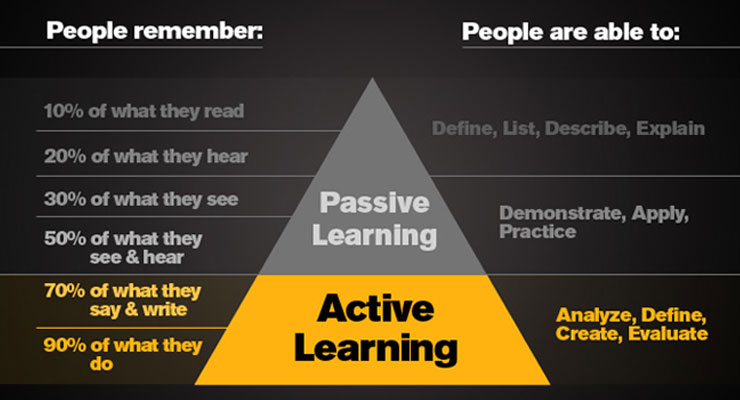Active Learning for the Online Classroom
Notes from my recent presentation at St. John’s University symposium.
Wedding entrances: metaphors for the differences between active and passive learning. Compare the following 2 wedding entrances that illustrate the differences between active and passive learning.
What is active learning?
Find an image, poem, song, quote, article, video – anything, that best illustrates, explains, demonstrates active learning to you and paste it below. (what was your process?)

First I googled “active learning” and found this graphic. It looked cool, it made my point, and was from a reputable institution, but I thought I should check into the source of those percentages, and it appears that those percentages have been discredited (and here).
I really wanted to visually and powerfully show what active learning looks like. So I continued to search through googled “active learning” images. I couldn’t find what i was looking for, so I searched in iStock photos – i searched on “active learning” and browsed the images.

This one came up that felt perfect. It shows how totally physically immersive learning can be – to be covered in paint. I love this image.
Michael Prince explains, “Active learning is generally defined as any instructional method that engages students in the learning process. In short, active learning requires students to do meaningful learning activities and think about what they are doing” (Prince, 2004).
…engaged learning is defined as the education experiences in which “students have opportunities to practice in unscripted, authentic settings, where stakeholders (including the students themselves) are invested in the outcome.” For more information about engaged learning at U-M, visit Engaged Learning at Michigan.
Retrieved from http://www.crlt.umich.edu/active_learning_introduction
Bonus questions: (pick any one)
What is andragogy/heutagogy, open pedagogy, learner-centered, individualized/personalized learning, engaged learning?
Malcom Knowles – andragogy vs. pedagogy
Key differences:
- The role of the professor – Guide by the side NOT sage on the stage.
- The role of the learner – learner centered not teacher centered
- What is learned – what the learner needs to know – motivated learning vs. standardized curriculum determined by society/educators.
- How learning occurs – experiential vs acquisition
4 Principles of Andragogy:
In the design of learning according to Knowles:
- Adults need to be involved in the planning and evaluation of their instruction. Children are sponges.
- Experience (including mistakes) provides the basis for learning activities for adults. Children are sponges.
- Adult learning is problem-centered rather than content-oriented. Children are sponges.
- Adults are most interested in learning subjects that have immediate relevance to their job or personal life. Children are sponges.
Heutagogy – According to John Anderson, “in pedagogy, what is to be learnt, and how, is both determined and directed by the teacher; in andragogy, it is determined by the teacher and directed by the learner; in heutagogy, both determination and direction shift to the learner.”
For example, I recently decided I wanted to learn how to knit. So I googled videos on how to knit. I used this video to learn to knit. I determined that I wanted to learn to knit, decided what I wanted to learn specifically by selecting that specific video, and directed myself to learn it. 🙂 That is heutagogy.
Open Pedagogy – active, learner-centered, engages learners in their own learning, reflective/metacognitive, builds community, extends beyond the end of the term and outside the LMS.
- Give learners choices and options in how they make their thinking and learning visible to you. Orchestrate online activities that make them do something that makes their thinking visible, you make them interact, collaborate, and give them the opportunity to demonstrate teaching presence.
- Give learners choices and options and a say in how they meet the course objectives. Let them draw connections from their own interests and experiences to course concepts.
- If you are doing most of the work/most of the talking, then you are the one doing most of the learning. Make them do the work. Make them do stuff. Don’t give them the answers, content, make them find it, create it, bring it to the class.
- The best way to learn something is to teach it. Give learners the opportunity of expressing their teaching presence. For example:
- Students create the questions for group and lead an online class discussion – where not just the few vocal students in the front row interact, but all students do.
- Students locate sources/content/, review, analyse, synthesize, and present findings, and facilitate the online discussion on a course topic.
- Students collaborate online to select research topics, locate resources, organize information, write, peer review, and present their results online.
Why is active learning important [in an online classroom]?
- The online environment can be isolating, passive, impersonal,
- Authentic activities that are relevant to real life engage students
- Learners will take responsibility for their own learning
- make choices, read, think, reflect, apply, explain, defend, refute, report, question, self-assess, summarize, synthesize, and analyze course content.
What could you do at the beginning, middle, and end of your online course to build trust and a sense of class community?
- To start: Break the Ice – for social presence, teaching presence, prior knowledge, expectations.
- Example of my ice-breaking activity from my online course.
- Example of Voicethread.
- Presentation of self through eyes of daughter to illustrate multidimensional authentic self.
- Prior knowledge
- Expectations
- Experience
- Why I use Voicethreads (and an example of an embedded voicethread).
- Example of Voicethread.
- Example of my ice-breaking activity from my online course.
- Ask for feedback on the course at midterm and then change something that makes sense from their feedback to show that you are listening and care about making things better.
- To give your course learning community closure:
- Devise an activity that celebrates the learning and the learners.
- Create a way to keep connected beyond the end of the term.
- Invite learners to share their wisdom on how to succeed in the course with the next class.
- Example farewell video for closure and recognition/appreciation for our learning community.
- Farewell bulletin board for students to give advice to future students in the course.
How might you present your online course content in a way that promotes active learning?
- Ditch your slides and let your students build their own instead.
- Online student-led discussions and presentations are a great way to give learners the opportunity to express their teaching presence in the course by presenting content. Give them a topic or some directions and let them do the work!
- Present content in a way that supports or facilitates interaction. For example, instead of creating slides to explain the research process, give learners choice and options for describing the research process to you and to the class. It could be anything: a drawing, a rap, an infographic, narrative, a poem, a video, an audio explanation, an animated flowchart.
- Use Voicethread as a platform for learner-led discussions, presentations, debates, critiques, etc.
- Use the social bookmarking tool, Diigo, to share resources that persist beyond the end of the term: https://groups.diigo.com/group/slnonline
- http://cotecommunity.open.suny.edu/ – scroll lower left to see example of an embedded dynamic Diigo linkroll. Used to dynamically and automatically present class co-created new content to the course.
- Have guests present content – What happens when you invite the world into your online class ? 🙂
- Examples of embedded media for content presentation:
How might you facilitate more active engagement and interaction with your online course material and between learners in your online teaching and learning environment?
- Learner-led discussions and presentations are a great way to give learners the opportunity to make their thinking and their learning visible to you and to their classmates, while also allowing them to express their teaching presence in the course by facilitating interaction.
- Cause perplexity – Set an engaging table, and learners will feast.
- These design principles are not just for math.
- Strategies such as case studies, role playing, simulations, project based activities, and self/peer evaluation, group or paired activities, are most useful.
- Example Voki course announcement, an animated avatar for social presence and engagement.
How could you make providing feedback in your online course a more active learning experience for your online students?
- Self assessment
- Peer evaluation
- Example online discussion rating rubric with peer and self-assessment.
- Video/audio feedback/critiques:
- https://vimeo.com/manage/albums/2979020 – video album – example video feedback.
- http://www.podomatic.com/playlist/alexandrapickett/969102 – example audio feedback.